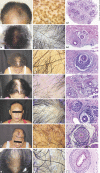Fibrosing Alopecia in a Pattern Distribution (FAPD) in 16 African-Descent and Hispanic Female Patients: A Challenging Diagnosis
- PMID: 31367598
- PMCID: PMC6615333
- DOI: 10.1159/000496837
Fibrosing Alopecia in a Pattern Distribution (FAPD) in 16 African-Descent and Hispanic Female Patients: A Challenging Diagnosis
Abstract
Background: Fibrosing alopecia in a pattern distribution (FAPD) has only been described in Caucasian patients, and it is not clear whether it can develop in dark-skin ethnicities.
Materials and methods: Sixteen Brazilian female patients, 12 of African descent and 4 Hispanic, with progressive scarring alopecia in a pattern distribution were analyzed.
Results: Dermatoscopic features showed perifollicular erythema and scaling (14/16), hair fiber diameter diversity (16/16), loss of follicular ostia (16/16), and follicular keratosis (3/16). Late stages showed a honeycomb pigmented network (12/16), a hyperpigmented perifollicular halo (12/16), and small white patches (12/16). Histopathological features showed lichenoid perifollicular infiltrate (14/16), follicular miniaturization (16/16), concentric fibrosis (16/16), perifollicular lymphocytic infiltrate (16/16), and vellus hair involvement (10/16). Premature desquamation of the inner root sheath was found in 11 patients.
Conclusions: The concomitant findings of cicatricial pattern hair loss (with or without the recess of the front hair line), hair fiber diversity, perifollicular erythema and scaling, a whitish perifollicular halo, and histological findings of androgenetic alopecia, with vacuolar interface alteration of the upper portion of the follicular epithelium, are the main key features to suggest the diagnosis of FAPD. FAPD is a possible diagnosis in patients of color with cicatricial pattern hair loss. Clinical, dermatoscopic, and histopathological examination allow a proper final differential diagnosis.
Keywords: Androgenetic alopecia; Cicatricial alopecia; Female alopecia; Fibrosing alopecia in a pattern distribution.
Conflict of interest statement
The authors declare that they have no conflicts of interest to disclose.
Figures

References
-
- Zinkernagel MS, Trüeb RM. Fibrosing alopecia in a pattern distribution: patterned lichen planopilaris or androgenetic alopecia with a lichenoid tissue reaction pattern? Arch Dermatol. 2000 Feb;136((2)):205–11. - PubMed
-
- Sperling L, Cowper S, Knopp E. Informa healthcare. 2012. An atlas of hair pathology with clinical correlations USA T&F, editor.
-
- Mardones F, Hott K, Martinez MC. Clinical study of fibrosing alopecia in a pattern distribution in a Latin American population. Int J Dermatol. 2018 Feb;57((2)):e12–4. - PubMed
-
- Olsen EA. Female pattern hair loss and its relationship to permanent/cicatricial alopecia: a new perspective. J Investig Dermatol Symp Proc. 2005 Dec;10((3)):217–21. - PubMed
LinkOut - more resources
Full Text Sources

